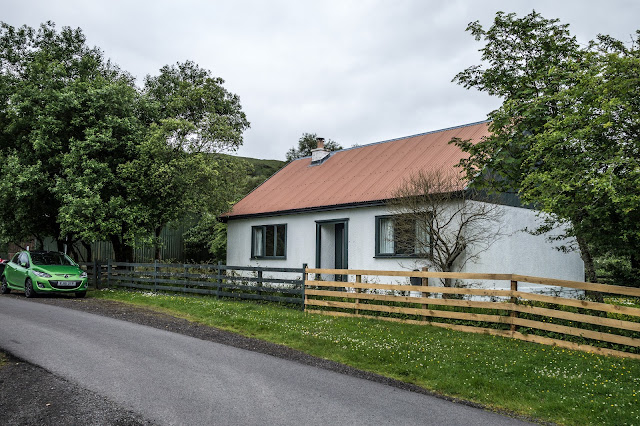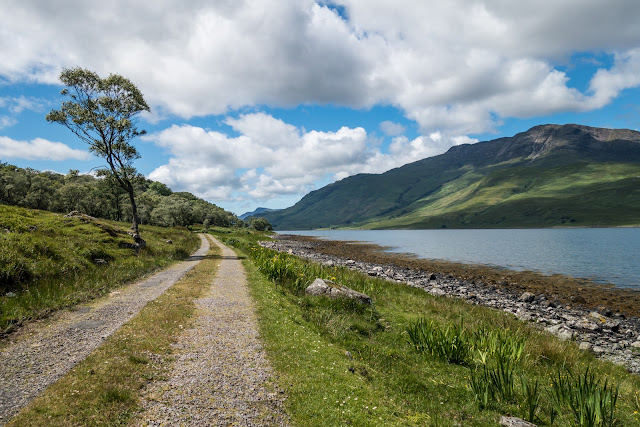Our arrival in Mull
This was a holiday we had looked forward to for a long time, having spoken several times of visiting the isles of Scotland. So here we were about to spend a week on Mull. Having spent the night in an hotel on the banks of Lock Lomond, we set of today for the Oban ferry.
We sailed from Oban (above) on the mainland to Craignure on our Mull adventure. The weather looking rather gloomy and misty but the 45 min. passed quickly before we arrived in Craignure in like style - misty and murky!
We sailed from Oban (above) on the mainland to Craignure on our Mull adventure. The weather looking rather gloomy and misty but the 45 min. passed quickly before we arrived in Craignure in like style - misty and murky!
After a short drive, we arrived at our holiday destination, Ardura Cottage. We were just a short drive south of Craignure, with rolling hills behind us, and set for the week. Only a few mosquitoes in sight - thankfully!
Next morning , more of the same mist, but not downhearted, we set off for ...
You guessed - Tobermory!
On the way we had to stop and photograph these old hulks of fishing vessels.
And arrived in the now famous town with it`s wonderfully coloured waterfront houses. Despite the unhelpful dull weather, it still looked as I had envisioned it.
Tobermory owes its origins to the British Fisheries Society and their search for likely sites for fishing communities in western Scotland in the 1700s. The Society's agent, John Knox, visited Mull in 1786 and proposed making use of the superb natural harbour for such a community. The name comes from the Gaelic tobar-mhoire which translates as "Mary's Well", after an ancient holy well dedicated to the Virgin Mary in what is now the upper part of the village.
Today Tobermory, the undisputed island capital of Mull, has a population of just over 1,000 people. These days it is perhaps best known for its connections with children's TV. First it had a Womble named after it, while a little more recently it was used as the setting for the BBC children's series Balamory.
This turned Tobermory into a place of pilgrimage for many young fans and their parents. Although filming stopped in 2005, the appearance of the series on DVD means it still pays to book your accommodation and ferry tickets ahead if you intend to visit.
Tobermory wraps around the bay that led to its construction. It faces south east into the Sound of Mull, and is additionally protected by Calve Island which half encloses the bay. Main Street hugs the harbour, with additional development on the hillside behind.
Tobermory's most distinctive feature lies in the brightly painted frontages of many of its buildings. The pink, yellow and blue run of the three buildings centered on the Mishnish Hotel near the south east end of the harbour was for many years the most striking segment. In 2006 the palette changed, with the Mishnish being painted a more traditional black and its previously bright pink neighbour being toned down. The Mishnish Hotel has been returned to its earlier yellow since our most recent visit, and Tobermory has returned to being the brightest and one of the most attractive harboursides in Scotland.
Rusty chains on the waterfront
The ever present gull watches over proceedings, no doubt anticipating some lunch.
I just loved the patterns of these
Later in the day, when we were back at our cottage, we decided to have a stroll along the nearby lanes. The butterfly above took our attention and a reasonable image taken. It is in fact a Small Argent & Sable (Epirrhoe tristate)
This was the beautiful scene behind our cottage as the sunlight slid across the hills.
We were later treated to a display, as a local farmer rounded up his sheep in the field opposite the cottage.
Next morning we set off to explore, and headed for Carsaig, having enjoyed views over Loch Scridain on the way, before turning at Pennyghael, for our destination.
And then onto Carsaig Bay a cove on the Ross of Mull in the south of the island of Mull. It is situated along a "narrow unclassified road". The bay is small and is surrounded by high, precipitous hills - the approach was so steep that Rosey preferred to walk down while I brought the car! It is unsafe for water craft, except in the part sheltered by the island of Gamhnach Mhòr, where small vessels can obtain anchorage.
Unsure sheep on the way!
Masses of sea weed on side of Loch Scridain
The reader - seen in a remote corner of Carsaig bay, taking in the peace and quiet - until we arrived. There are some interesting rock features nearby, but the very rough terrain and high tide made walking to them, out of the question. Anyway, a great place for lunch.
The Maclean coat of arms on a run down and isolated building near Carsaig.
Clan MacLean is a Highland Scottish clan. They are one of the oldest clans in the Highlands and owned large tracts of land in Argyll as well as the Inner Hebrides. Many early MacLeans became famous for their honour, strength and courage in battle. They were involved in clan skirmishes with the Mackinnons, Camerons, MacDonalds and Campbells, as well as all of the Jacobite risings.
Although the usual fanciful pedigrees locates the clan originally 150 miles north east at Glen Urquhart in Moray, the Macleans are from the west coast island of Mull.
I was pleased to find this old coat of arms in this deserted spot.
Boat reflections - Carsaig Bay
A bridge near Pennyghael, visited on the way back home.























Comments